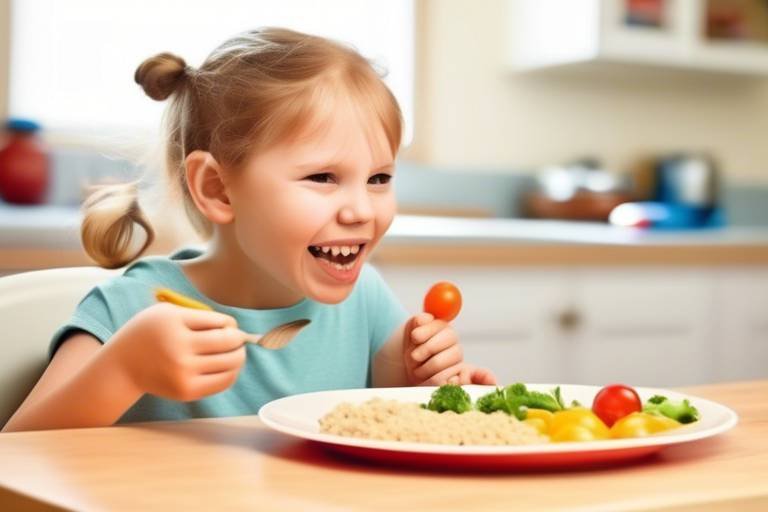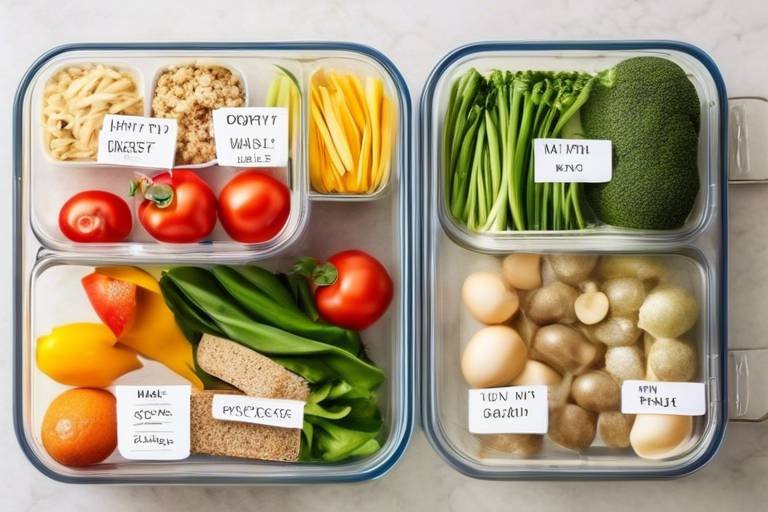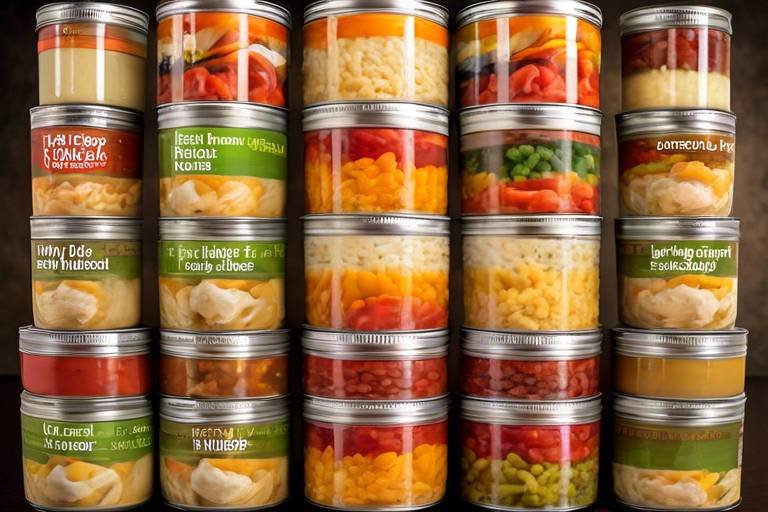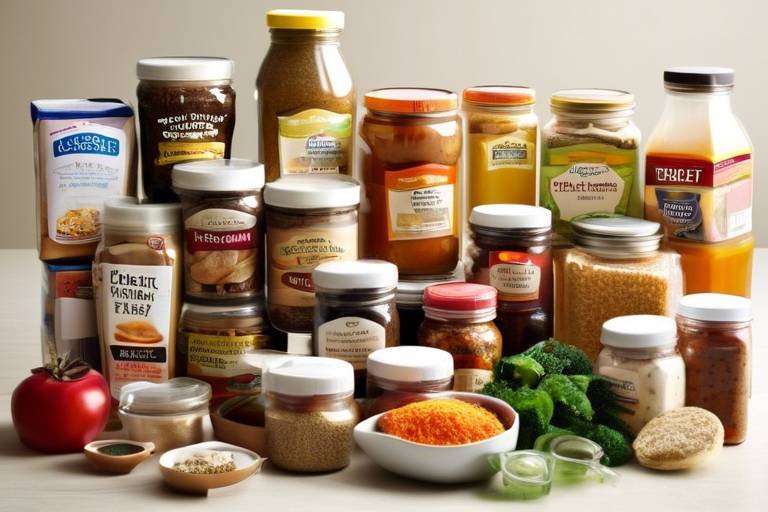The Importance of a Multicolored Diet for Kids
In today's fast-paced world, ensuring that our kids eat a varied and colorful diet can sometimes feel like a daunting task. But did you know that the colors on your child's plate are not just for aesthetics? Each hue represents a unique set of nutrients that are essential for their growth, development, and overall health. A multicolored diet is not merely a trend; it's a vital component of a balanced nutrition plan that can set the foundation for lifelong healthy eating habits. Think of it as a vibrant rainbow of health benefits, where each color brings something special to the table!
Imagine a plate filled with bright reds, deep greens, sunny yellows, and rich purples. Each color signifies a different group of vitamins and minerals that play crucial roles in your child's body. For instance, red foods are often rich in antioxidants, while green foods provide essential vitamins that support growth. By encouraging your children to embrace a variety of colors, you're not just making their meals visually appealing; you're also ensuring that they receive a comprehensive array of nutrients necessary for their development.
Moreover, a colorful diet can also help in preventing chronic diseases later in life. When children are exposed to a wide range of fruits and vegetables, they develop a palate for diverse flavors, making them less likely to fall into the trap of picky eating as they grow older. It's like planting seeds for a lifetime of healthy choices! So, how can we make this colorful diet a reality in our homes? Let's dive deeper into the individual colors and their benefits.
A multicolored diet ensures children receive a wide range of vitamins and minerals. Each color represents different nutrients, contributing to overall health and well-being. For example, orange foods like carrots and sweet potatoes are packed with beta-carotene, which is crucial for eye health. Meanwhile, blue and purple foods, such as blueberries and eggplants, contain anthocyanins that have been linked to improved memory and cognitive function. By incorporating a spectrum of colors into meals, parents can help ensure that their children are getting the nutrients they need to thrive.
Fruits and vegetables are vital components of a multicolored diet. They provide essential nutrients, antioxidants, and fiber that support children's growth and immune systems. A diet rich in fruits and vegetables can help children maintain a healthy weight, reduce the risk of chronic diseases, and promote better digestion. Think of fruits and vegetables as nature's multivitamins—each bite is packed with goodness that fuels your child's body and mind!
Red foods, such as tomatoes and strawberries, are rich in antioxidants like lycopene and vitamin C, promoting heart health and boosting the immune system. These nutrients can help protect against illnesses and keep your child's heart strong. Not to mention, they add a burst of flavor and color to any dish!
Common red foods include:
- Cherries
- Beets
- Red bell peppers
All of these options offer unique health benefits and flavors to enhance children's meals.
Green foods, including spinach and broccoli, are packed with vitamins A, C, and K, which are essential for children's growth, bone health, and overall development. These nutrients play a significant role in building strong bones and supporting the immune system. Plus, they can be incorporated into various dishes, from smoothies to stir-fries, making them versatile and easy to include in your child's diet.
Yellow and orange foods like carrots and oranges are high in beta-carotene and vitamin C, supporting eye health and boosting the immune system in children. These nutrients are crucial for maintaining good vision and fighting off infections, making them a must-have in your child's diet.
Foods in this color group help improve skin health and provide energy, making them an important part of a child's daily nutrition. They can also be fun to eat—think of all the bright, cheerful dishes you can create with these vibrant ingredients!
Parents can encourage a multicolored diet by creatively incorporating various colored foods into meals, making them appealing and nutritious for children. Try arranging fruits and vegetables in fun shapes, or involve your kids in the cooking process. This not only makes meals more exciting but also helps children understand the importance of eating a variety of foods.
Many children are picky eaters, but introducing a variety of colorful foods can help expand their palates and encourage healthier eating habits. It’s all about making the experience enjoyable and engaging for them!
Using fun presentations, involving kids in meal prep, and educating them about the benefits of colorful foods can motivate children to try new things. For instance, you might create a "rainbow plate" challenge, encouraging them to choose one food from each color group. This not only makes eating fun but also instills a sense of achievement when they complete their colorful plate!
Q: How can I encourage my child to eat more colorful foods?
A: Get creative with meal presentations, involve them in cooking, and educate them about the health benefits of different colored foods.
Q: Are there any specific colorful foods that are particularly beneficial?
A: Yes! Foods like spinach (green), carrots (orange), and blueberries (blue) are packed with essential nutrients and can greatly benefit your child's health.
Q: What if my child is a picky eater?
A: Start by introducing small amounts of new foods alongside their favorites, and make meals fun and engaging to encourage them to try new things.

Understanding Nutrient Diversity
When it comes to our children's health, we often focus on proteins, carbs, and fats, but there's a whole rainbow of nutrients waiting to be discovered! A multicolored diet is not just a feast for the eyes; it’s a treasure trove of vitamins and minerals that are essential for a child's growth and development. Imagine each color of food as a superhero, each with unique powers that contribute to overall well-being. For instance, the vibrant reds and greens in our meals are not just there for decoration; they play crucial roles in keeping our kids healthy and happy.
Each color of food corresponds to different nutrients. For example, red foods are often rich in antioxidants like lycopene, which is fantastic for heart health, while green foods are loaded with vitamins that support strong bones and a robust immune system. It's like a nutritional symphony where every color plays its part, harmonizing to create a balanced diet. When children consume a variety of colors, they are more likely to get the full spectrum of nutrients they need. This is crucial because each nutrient has its unique benefits, and a deficiency in any one of them can lead to health issues.
To illustrate the diversity of nutrients found in different colored foods, here’s a quick overview:
| Color | Examples | Nutrients | Health Benefits |
|---|---|---|---|
| Red | Tomatoes, strawberries, cherries | Lycopene, Vitamin C | Heart health, immune support |
| Green | Spinach, broccoli, green apples | Vitamins A, C, K | Bone health, growth support |
| Yellow/Orange | Carrots, oranges, bell peppers | Beta-carotene, Vitamin C | Eye health, skin health |
| Purple/Blue | Blueberries, eggplants, purple grapes | Antioxidants, Vitamin K | Brain health, anti-inflammatory |
By incorporating a variety of colors into meals, parents can ensure their children are not only eating a visually appealing plate but also receiving a well-rounded nutrient profile. It's like painting a masterpiece on a canvas, where each color enhances the overall picture. So, the next time you're planning a meal, think about how you can add a splash of color to your child's plate! Not only will it make mealtime more fun, but it will also help them grow into healthy, strong individuals.

The Role of Fruits and Vegetables
When it comes to a multicolored diet, fruits and vegetables play a starring role in ensuring that children receive the necessary nutrients for their growth and development. These vibrant foods are not just visually appealing; they are packed with essential vitamins, minerals, and antioxidants that help support a child's immune system and overall health. Imagine fruits and vegetables as the superheroes of nutrition, each color representing a unique set of powers that contribute to a child's well-being.
Incorporating a variety of fruits and vegetables into a child's diet can be both fun and beneficial. For example, the bright orange of a carrot isn't just for show; it's a signal that it’s loaded with beta-carotene, which the body converts into vitamin A, crucial for vision and immune function. Similarly, the deep greens of spinach and kale are rich in iron and calcium, essential for growing bones and muscles. By making meals colorful, parents can ensure that their children are not only enjoying their food but also getting a wide range of nutrients.
But why stop at just one or two colors? Each color group provides different health benefits, making it vital to include a rainbow of options in daily meals. Here’s a quick breakdown of the benefits associated with various colored fruits and vegetables:
| Color | Examples | Health Benefits |
|---|---|---|
| Red | Tomatoes, strawberries, red peppers | Rich in antioxidants, supports heart health |
| Green | Broccoli, spinach, green apples | Packed with vitamins A, C, and K, promotes bone health |
| Yellow/Orange | Carrots, sweet potatoes, oranges | High in vitamin C and beta-carotene, boosts immunity |
| Purple/Blue | Blueberries, eggplants, purple cabbage | Contains anthocyanins, supports brain health |
By understanding the specific benefits of each color, parents can make informed choices about what to include in their children's meals. For instance, a smoothie made with spinach (green), banana (yellow), and blueberries (blue) not only looks appealing but also provides a powerhouse of nutrients.
Involving children in the selection and preparation of these colorful foods can also foster a sense of ownership over their meals. When kids help wash, peel, or even pick out the fruits and vegetables at the grocery store, they are more likely to be excited about eating them. This hands-on approach can transform mealtime from a chore into an adventure, sparking curiosity about different flavors and textures.
Ultimately, the role of fruits and vegetables in a child's diet cannot be overstated. They are not just side dishes; they are essential components that fuel growth, support health, and cultivate lifelong healthy eating habits. By encouraging a colorful diet, parents can set their children on a path to a healthier future, one delicious bite at a time.

Red Foods and Their Benefits
When we think about red foods, we often picture vibrant fruits and vegetables that not only look appealing but also pack a serious nutritional punch. These foods, such as tomatoes, strawberries, and red bell peppers, are rich in antioxidants, vitamins, and minerals that play a crucial role in our children's health. One of the standout components found in many red foods is lycopene, a powerful antioxidant that has been linked to heart health and cancer prevention. Not to mention, red foods are also high in vitamin C, which is essential for boosting the immune system and promoting healthy skin.
But why should we focus on getting more red foods onto our kids' plates? Well, it's simple! The vibrant colors of these foods are not just for show; they signify the presence of various beneficial compounds. For instance, the antioxidants in red foods help combat oxidative stress in the body, which can lead to chronic diseases. Moreover, incorporating these colorful foods into meals can make eating an exciting adventure for kids. Imagine a plate filled with juicy red strawberries, tangy tomatoes, and sweet cherries—how can anyone resist?
Here's a quick look at some popular red foods and their unique benefits:
| Red Food | Key Nutrients | Health Benefits |
|---|---|---|
| Tomatoes | Lycopene, Vitamin C | Promotes heart health, reduces cancer risk |
| Strawberries | Vitamin C, Folate | Boosts immune system, supports skin health |
| Red Bell Peppers | Vitamin A, Vitamin C | Improves vision, enhances immunity |
| Cherries | Antioxidants, Vitamin C | Reduces inflammation, supports sleep |
Incorporating these red foods into your child's diet can be as easy as adding sliced strawberries to their breakfast cereal or tossing red bell peppers into a stir-fry. The more variety, the better! Plus, when kids see a rainbow of colors on their plates, they're more likely to be excited about eating. So, let’s make it a goal to fill our grocery carts with these colorful delights. After all, a little creativity in the kitchen can go a long way in ensuring our children receive the nutrients they need to thrive.
- Why are red foods important for kids? Red foods are rich in antioxidants and vitamins that support heart health, boost immunity, and promote overall growth and development.
- How can I encourage my child to eat more red foods? Try making meals visually appealing by incorporating a variety of colors, involving them in meal prep, and explaining the health benefits of these foods.
- Are there any red foods that are particularly good for skin health? Yes, foods like strawberries and tomatoes are high in vitamin C, which is essential for healthy skin.

Examples of Red Foods
When it comes to adding a splash of color to your child's plate, red foods are not just visually appealing; they are packed with nutrients that play a crucial role in overall health. Think about the vibrant hues of a freshly sliced tomato or the juicy sweetness of a strawberry. These foods are not only delicious but also offer a myriad of health benefits that can help your child thrive. Here are some standout examples of red foods that you should consider incorporating into your child's diet:
- Cherries: These tiny powerhouses are loaded with antioxidants and anti-inflammatory compounds, making them a perfect snack for kids. Plus, they add a delightful sweetness to any meal!
- Beets: Often overlooked, beets are rich in fiber and essential vitamins. Roasted or pickled, they can add a unique flavor and vibrant color to salads.
- Red Bell Peppers: Crisp and crunchy, these peppers are an excellent source of vitamins A and C. They can be enjoyed raw in salads or cooked in various dishes, making them versatile and nutritious.
- Raspberries: Packed with dietary fiber and vitamin C, raspberries are perfect for smoothies or as a topping for yogurt. Their tartness can be a fun contrast to sweeter foods.
- Watermelon: Not only is watermelon hydrating, but it also contains lycopene, which is great for heart health. It’s a refreshing treat on a hot day!
Incorporating these red foods into your child's meals can be as simple as adding a few slices of red bell pepper to their lunchbox or blending some strawberries into a smoothie. The vibrant colors can make meals more appealing, and the diverse flavors can help keep their taste buds excited. Plus, teaching kids about the benefits of these foods can foster a lifelong appreciation for healthy eating.
So, the next time you're planning meals or snacks, remember that red foods can be a delightful and nutritious addition to your child's diet. They not only provide essential vitamins and minerals but also introduce a spectrum of flavors that can turn any meal into an adventure!

Green Foods for Growth
When it comes to healthy eating, green foods are like the superheroes of the vegetable world. Packed with nutrients, they play a crucial role in supporting children's growth and development. Think of green foods as the building blocks for a child’s body, providing essential vitamins and minerals that fuel their day-to-day activities. For instance, leafy greens such as spinach and kale are loaded with vitamins A, C, and K, which are vital for maintaining strong bones, healthy skin, and a robust immune system. Imagine a child’s body as a growing plant; just as plants need sunlight and water to thrive, children need these nutrients to flourish.
Green foods are not only nutritious but also versatile and delicious. They can be easily incorporated into meals in creative ways. For example, a simple smoothie can be transformed into a green powerhouse by adding a handful of spinach or kale. Similarly, a colorful stir-fry can feature vibrant green broccoli and snap peas, making it not only visually appealing but also a nutrient-dense option. The best part? Children often don’t even realize they’re eating something so healthy when it’s deliciously disguised!
Here’s a quick breakdown of some popular green foods and their benefits:
| Green Food | Key Nutrients | Health Benefits |
|---|---|---|
| Spinach | Vitamins A, C, K, Iron | Supports bone health, boosts immunity, and improves skin health. |
| Broccoli | Vitamins C, K, Folate | Promotes healthy digestion and strengthens the immune system. |
| Kale | Vitamins A, C, K, Calcium | Enhances cardiovascular health and supports bone strength. |
| Zucchini | Vitamin C, Potassium | Helps maintain hydration and supports heart health. |
Incorporating these green foods into your child’s diet can be a fun adventure. Try hosting a “green day” where every meal features a different green food. You can also involve your children in the cooking process—let them wash, chop, or even choose which greens to include. This way, they’ll feel more connected to their meals and more likely to eat what they’ve helped prepare. Remember, it’s all about making healthy eating an enjoyable experience!
- Why are green foods important for children? Green foods provide essential nutrients that support growth, immunity, and overall health.
- How can I get my child to eat more green foods? Try involving them in meal preparation and making the foods visually appealing.
- Are frozen green vegetables as nutritious as fresh ones? Yes, frozen vegetables can be just as nutritious and are often picked at peak ripeness.

Yellow and Orange Foods
When it comes to nourishing our little ones, are like sunshine on a plate! These vibrant hues are not just visually appealing; they’re packed with essential nutrients that can significantly benefit children's health. Foods like carrots, sweet potatoes, and oranges are rich in beta-carotene, which the body converts into vitamin A. This powerhouse vitamin plays a crucial role in maintaining good vision, supporting immune function, and promoting healthy skin. Imagine your child's immune system as a superhero—beta-carotene is one of its secret weapons!
But that’s not all! Yellow and orange foods are also loaded with vitamin C, which is vital for growth and development. This important nutrient helps the body absorb iron, supports the immune system, and even aids in wound healing. Think of vitamin C as a friendly sidekick, always ready to boost your child's defenses against colds and infections. For instance, a simple orange can provide a refreshing snack while delivering a hefty dose of this essential vitamin.
Incorporating these colorful foods into your child's diet can be both fun and rewarding. Here are some popular yellow and orange foods that you might want to consider:
- Carrots: Crunchy and sweet, perfect for snacking or adding to meals.
- Sweet Potatoes: A versatile option that can be mashed, baked, or made into fries.
- Peppers: Yellow and orange bell peppers add a sweet crunch to salads and stir-fries.
- Mangoes: Juicy and delicious, they make for a great dessert or smoothie ingredient.
- Pineapples: Sweet and tangy, they can be enjoyed fresh or in fruit salads.
Moreover, yellow and orange foods are often high in fiber, which is essential for digestive health. Fiber helps keep things moving in the digestive tract, preventing constipation and promoting a healthy gut. So, when you serve up a plate of colorful veggies, you’re not just making it look good; you’re also contributing to your child's overall well-being!
To make these foods even more enticing, consider presenting them in creative ways. For example, you could make a rainbow salad that showcases a variety of colorful veggies, or blend yellow and orange fruits into a smoothie that looks as good as it tastes. The goal is to make healthy eating a fun and enjoyable experience for your children, encouraging them to explore the wonderful world of colorful foods.

Health Benefits of Yellow Foods
When we think of yellow foods, we often picture bright, sunny fruits and vegetables that not only look appealing but also pack a powerful punch of nutrients. Foods like carrots, bananas, and sweet corn are not just delicious; they are essential for children's health. One of the primary benefits of yellow foods is their high content of beta-carotene, which the body converts into vitamin A. This nutrient is crucial for maintaining healthy vision, especially in growing children who are constantly exploring their world. Imagine a child playing outside, their eyes bright and clear, all thanks to the vibrant yellow foods they consume!
Moreover, yellow foods are typically rich in vitamin C, which is vital for a robust immune system. This nutrient helps the body fight off infections and illnesses, making it essential for active kids who are always on the go. Think of vitamin C as a shield, protecting your child from the various germs and viruses they encounter daily. Foods like oranges and pineapples not only taste great but also serve as delicious defenses against sickness!
In addition to these vitamins, yellow foods often contain important minerals like potassium and magnesium. These minerals play a significant role in muscle function and energy production, which are essential for children who are constantly running, jumping, and playing. Including a variety of yellow foods in their diet can help ensure that kids have the energy they need to thrive throughout the day.
To illustrate the benefits of yellow foods, consider the following table showcasing some popular yellow foods and their primary health benefits:
| Food | Primary Health Benefits |
|---|---|
| Carrots | Rich in beta-carotene for vision health |
| Bananas | High in potassium for muscle function |
| Yellow Peppers | Excellent source of vitamin C for immune support |
| Sweet Corn | Provides energy and fiber for digestive health |
Incorporating these yellow foods into meals can be fun and creative. Consider adding sliced bananas to your child’s morning cereal or blending some sweet corn into a hearty soup. The key is to make these foods appealing and accessible. After all, a colorful plate is not only visually stimulating but also a sign of a well-rounded diet. So, next time you're at the grocery store, don’t forget to load up on those bright yellow foods for your little ones!
Q1: Why are yellow foods important for kids?
A1: Yellow foods are rich in essential nutrients like beta-carotene and vitamin C, which support vision, boost the immune system, and provide energy for active kids.
Q2: How can I encourage my child to eat more yellow foods?
A2: Make yellow foods appealing by incorporating them into fun recipes, creating colorful meals, and involving your child in meal preparation to spark their interest.
Q3: Are there any other benefits to eating a variety of colored foods?
A3: Yes! A diverse diet ensures that children receive a wide range of vitamins and minerals, promoting overall health and well-being.

Incorporating Colorful Foods into Meals
When it comes to getting kids to eat a variety of foods, presentation is key! Think of their plates as a canvas where you can create a masterpiece that not only looks good but also packs a nutritional punch. One of the simplest ways to introduce a multicolored diet is by incorporating colorful foods into every meal. Imagine a plate filled with vibrant greens, reds, yellows, and oranges—it's like a rainbow of health right in front of them!
Start with breakfast, where you can mix in colorful fruits like berries, bananas, and kiwis into their cereal or yogurt. Not only does this add flavor, but it also provides essential vitamins to kick-start their day. For lunch, consider packing a colorful salad with spinach, cherry tomatoes, carrots, and cucumbers. You can even let your kids help by choosing their favorite toppings, making them more excited to eat their greens!
Dinner can be a fun opportunity to get creative. Think about making a stir-fry with a mix of bell peppers, broccoli, and snap peas. The vibrant colors not only make the dish visually appealing but also ensure a range of nutrients. You could even create a colorful taco bar where kids can choose their toppings. Picture this: a platter filled with avocado, corn, red cabbage, and black beans. They can mix and match, making every bite a new adventure!
To take it a step further, consider using fun shapes and designs. Use cookie cutters to create fun shapes out of fruits and vegetables. A star-shaped cucumber or a heart-shaped watermelon can turn an ordinary meal into something extraordinary. Kids are naturally drawn to fun shapes, and this can encourage them to try new foods they might otherwise shy away from.
Don't forget about snacks! Incorporate colorful options like hummus with a variety of veggie sticks—think vibrant carrots, bell peppers, and cucumbers. You can even set up a “colorful snack station” where kids can choose their favorite colorful foods to create their own snack mixes. This not only encourages them to eat healthier but also gives them the autonomy to explore different flavors and textures.
Incorporating colorful foods into meals is not just about nutrition; it's about making mealtime an enjoyable experience. By presenting food in a fun and appealing way, you can help your children develop a love for a variety of healthy foods. So, let your creativity flow and watch as your kids embrace a colorful, nutritious diet!
- Why is a multicolored diet important for kids?
A multicolored diet ensures that children receive a wide range of vitamins and minerals, supporting their overall health, growth, and development. - How can I make vegetables more appealing to my kids?
Try using fun shapes, involving them in meal prep, and presenting them alongside colorful dips or dressings to make them more enticing. - What are some easy ways to incorporate colorful foods into breakfast?
Add a variety of fruits to cereals, smoothies, or yogurt, and consider colorful vegetable omelets for a nutritious start to the day.

Overcoming Picky Eating
Picky eating can feel like a formidable challenge for parents, but it’s important to remember that it’s a common phase many children go through. In fact, around 50% of children experience some degree of picky eating. The good news is that with a little creativity and persistence, you can help your child develop a more adventurous palate. Think of it as a culinary treasure hunt, where each colorful food is a gem waiting to be discovered! By introducing a variety of vibrant foods, you can gradually expand their taste preferences and encourage healthier eating habits.
One effective strategy is to involve your children in the meal preparation process. Kids are often more willing to try new foods when they’ve had a hand in making them. Let them pick out fruits and vegetables at the grocery store, or assign them simple tasks in the kitchen, like washing produce or stirring a pot. This not only makes them feel empowered but also sparks their curiosity about the foods they are preparing.
Another fun approach is to present meals in a visually appealing way. You can create a “rainbow plate” filled with a variety of colorful foods. This not only looks enticing but also makes it easier for children to understand the concept of a multicolored diet. You might say, “Look at all these colors! Which one do you want to try first?” This playful engagement can make a significant difference in their willingness to sample new foods.
Education plays a vital role in overcoming picky eating as well. Take the time to explain the benefits of colorful foods. For instance, you could share how carrots help with eyesight or how spinach is a powerhouse for strong bones. Kids often respond well to stories and facts, and knowing that these foods can make them stronger and healthier can motivate them to try something new.
Lastly, be patient and persistent. It might take several exposures to a new food before your child is willing to try it. Instead of forcing them to eat, encourage small tastes. Celebrate every little victory, whether it’s a single bite or just a willingness to touch a new food. Remember, the goal is to create a positive atmosphere around food, not to turn mealtime into a battleground.
- What are some signs of picky eating? Picky eaters often refuse to try new foods, have a limited range of accepted foods, or may only prefer certain textures or colors.
- How can I encourage my child to eat vegetables? Try incorporating vegetables into fun recipes, smoothies, or dips that make them more appealing.
- Is it normal for children to go through phases of picky eating? Yes, many children experience phases of picky eating, and it usually resolves over time with gentle encouragement.

Strategies for Encouraging Variety
Encouraging children to embrace a multicolored diet can sometimes feel like an uphill battle, especially when faced with picky eaters. However, there are several effective strategies that can make this journey not only easier but also enjoyable for both parents and kids. First and foremost, involvement is key. When children participate in meal preparation, they are more likely to be excited about the foods they help create. This can involve simple tasks like washing vegetables, stirring ingredients, or even choosing which colorful foods to include in the meal. When kids feel a sense of ownership, they are more inclined to try what they’ve helped prepare.
Another effective way to encourage variety is through fun presentations. Kids are naturally drawn to visually appealing meals, so why not make food fun? Try arranging fruits and vegetables into colorful shapes or creating a rainbow plate. For instance, you could create a “rainbow wrap” using a whole-grain tortilla filled with layers of red bell peppers, green spinach, yellow corn, and purple cabbage. Not only does this look appealing, but it also provides a spectrum of nutrients!
Education also plays a crucial role in expanding a child's palate. Teaching kids about the health benefits of different colored foods can spark their curiosity. For example, you might explain how orange carrots help improve their eyesight or how green broccoli is a superhero for their bones. You could even create a fun chart that highlights these benefits, making it easy for kids to understand why they should eat a variety of foods.
Lastly, consider introducing new foods gradually. Instead of overwhelming your child with a plate full of unfamiliar items, try adding one new colorful food to a familiar dish. For example, if your child loves pasta, toss in some colorful cherry tomatoes or spinach. This approach not only eases them into trying new foods but also makes the experience less intimidating.
In conclusion, by involving children in the cooking process, presenting food in fun ways, educating them about health benefits, and gradually introducing new items, you can turn the challenge of picky eating into an exciting adventure. Remember, the goal is to create a positive experience around food that encourages a lifelong love for a diverse and colorful diet.
- Why is a multicolored diet important for kids?
A multicolored diet ensures that children receive a wide range of vitamins and minerals essential for their growth and development. - How can I get my child to try new foods?
Involve them in meal preparation, create fun presentations, and educate them about the benefits of different foods. - What are some examples of colorful foods?
Examples include red foods like tomatoes and strawberries, green foods like spinach and broccoli, and yellow/orange foods like carrots and oranges.
Frequently Asked Questions
- Why is a multicolored diet important for kids?
A multicolored diet is essential for children because it ensures they receive a variety of vitamins and minerals necessary for their growth and development. Each color of food represents different nutrients that contribute to overall health, helping to strengthen their immune systems and promote healthy growth.
- What are some examples of red foods and their benefits?
Red foods, such as tomatoes, strawberries, and cherries, are rich in antioxidants like lycopene and vitamin C. These nutrients are known to promote heart health, boost the immune system, and provide essential vitamins that support overall well-being.
- How do green foods contribute to a child's health?
Green foods, including spinach, broccoli, and kale, are packed with vitamins A, C, and K. These nutrients are crucial for children's growth, bone health, and immune function. Incorporating green foods into their diet can help ensure they are getting the nutrients they need for healthy development.
- What are the benefits of yellow and orange foods?
Yellow and orange foods, like carrots and oranges, are high in beta-carotene and vitamin C. These nutrients support eye health, boost the immune system, and improve skin health. Including these colorful foods in a child's diet can provide them with energy and essential nutrients.
- How can parents encourage their kids to eat a variety of colorful foods?
Parents can encourage a multicolored diet by creatively presenting meals, involving kids in meal preparation, and educating them about the health benefits of colorful foods. Making meals visually appealing and fun can motivate children to try new foods and develop healthier eating habits.
- What strategies can help overcome picky eating?
To overcome picky eating, parents can use strategies such as fun food presentations, offering a variety of textures and flavors, and involving children in cooking. Educating kids about the benefits of eating a rainbow of foods can also spark their interest in trying new things.



















